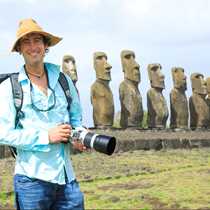Chatham Strait & Freshwater Bay
As the sun rose over Chatham Strait, the National Geographic Sea Lion was making its way north en route to Freshwater Bay. A group of guests were taking advantage of the clear morning, stretching on the sundeck with our wellness specialist Michelle, while others were greeting the day with a hot cup of coffee in the lounge. Just then, we got a call from our fearless expedition leader Jen Martin that a group of several humpback whales had been spotted in the distance.
We rose to the bow, and through our binoculars we counted more than a dozen whales diving down in synchronicity. Could this be the behavior which we were searching for, the most impressive display of mass and carnage, in fact the largest biomechanical event on Planet Earth? We waited and watched, and our hopes were granted as the dozen humpback whales lunged from the surface with mouths agape in a display called collaborative bubblenet feeding.
We were ecstatic. We made the call to the rest of ship, and while the breakfast tables sat set and ready, we stood on the bow in anticipation. As we neared, we saw the tremendous displays repeating as the whales would dive down and return in pursuit of their breakfast.
What is cooperative bubblenet feeding? It is a display exhibited by humpback whales, and best seen here in Southeast Alaska. When the whales are feeding on herring, they will all dive down and locate the school near the bottom. Then one whale will begin swimming around the school, blowing short bursts of air from its blowhole. The bubbles rise, they expand, scatter, and create a wall of bubbles, scaring the school into an ever-tightening ball. Then another whale gives a signal, a loud warrior-cry, and then all dozen humpbacks chase the herring up the vertical tower of bubbles until the surface where all open their gigantic mouths and engulf the school. From the ship, we got great views of the giants lunging, their mouths expanding large enough to engulf a VW Microbus, masked by the sounds of excitement and a thousand shutters firing.
After moving on from the excitement, we continued up through Freshwater Bay and decided to explore two tiny islands called Red Rocks. A naturalist and I set out ahead of the ship to scout for fun activities, and finding appropriate walks, we brought everyone ashore to join in the exploration. From our pleasant beach walk we got great views of more than a dozen curious harbor seals.
In the afternoon, the ship unloaded onto a beautiful harbor named Pavlof. Groups set out, hiking to a nearby waterfall, and up to a scenic lake. Other guests set out to observe the coastline and waterfall from sea level in our fleet of kayaks.
Meanwhile, I jumped into the 45-degree water with scuba gear and an underwater camera in search of underwater beauty. I was rewarded with many incredible sights, including a forest of giant plumose anemone, a clever fish called the crescent gunnel, and the most impressive sea star on earth, the sunflower star.
All in all, another perfect day aboard the National Geographic Sea Lion.




